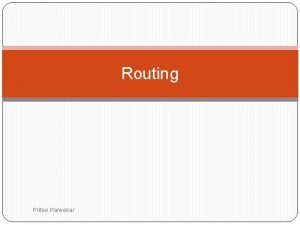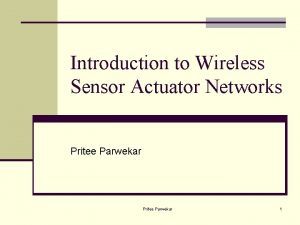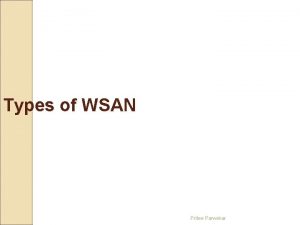Pritee Parwekar Pritee Parwekar Pritee Parwekar Pritee Parwekar






















- Slides: 22

Pritee Parwekar

Pritee Parwekar

Pritee Parwekar

Pritee Parwekar

Requirements and Standards • Some requirements for WSN deployment include: – Fault tolerance – Lifetime – Scalability – Real-time data collection – Security – Production Cost Pritee Parwekar 5

Fault Tolerant Mechanism • Mechanisms can be incorporated in any routing protocols for WSN to make it fault tolerant • It consists of four parts: – Failure detection – Failure information propagation – New parent detection – New parent selection Pritee Parwekar Shubhalaxmi Kher, Arkansas State University 6

Lifetime • Battery powered nodes calls for optimized code and network topology. • These factors must be considered with the design and implementation of WSN platforms, protocols, and applications. Pritee Parwekar Shubhalaxmi Kher, Arkansas State University 7

WSN requirements: Scalability • Wireless Sensor Networks may call for a large number of nodes. • Scalability will depend on the environment in which sensing is needed. • Range considerations will also need to be made for network topology and transmission power. Pritee Parwekar Shubhalaxmi Kher, Arkansas State University 8

IEEE 1451 Standard • The objective of this project is to develop a family of smart transducer interface standard IEEE 1451. • This set of standards is to make it easier for transducer manufacturers to develop smart devices. • Also to interface those devices to networks, systems, and instruments by incorporating existing and emerging sensor- and networking technologies. Pritee Parwekar 9

IEEE 1451 (contd. ) • IEEE 1451. 1 – Specifies collecting and distributing information over a conventional IP network. • IEEE 1451. 2 – Wired transducer interface – 12 wire bus working on a revision which will put IEEE 1451 on RS-232, RS-485 and USB. Pritee Parwekar 10

IEEE 1451 (contd. ) • IEEE 1451. 4 – This portion of the standard specifies the requirements for TEDS (Transducer Electronic Data Sheets). ***This is software only. • The IEEE is currently working on three different standards; 802. 11, Bluetooth, and Zigbee. Pritee Parwekar 11

IEEE 802. 15. 4 Standard • This standard specifies the PHY (physical) and MAC (Medium Access Control) layers for lowrate wireless personal area networks (LRWPANs). • Defines the channel access mechanism, acknowledged frame delivery, network association and disassociation. • Supports two Direct Sequence Spread Spectrum (DSSS) PHY layers operating in Industrial, Scientific, and Medicine (ISM) frequency bands. Pritee Parwekar 12

IEEE 802. 15. 4 (continued) IEEE 802. 15. 4 Frequency Bands and data rates Band 868 MHz 915 MHz 2. 4 GHz Region EU, Japan US Worldwide Channels 1 10 16 Data Rate 20 kbps 40 kbps 250 kbps Pritee Parwekar 13

IEEE 802. 11 Standard • Set of standards for implementing Wireless Local Area Network (WLAN) communication in the 2. 4, 3. 6, and 5 GHz frequency bands. • This standard defines the channels that subdivide different bands, minimizing local interference when deploying several networks in close proximity. • The latest protocol (802. 11 n) operates at a maximum data rate of 150 Mb/s. Pritee Parwekar 14

IEEE 802. 11 (contd. . ) • 802. 11 n supports 4 MIMO (multiple-input, multiple output) streams, where previous protocols only allowed 1, increasing performance. Pritee Parwekar 15

Variation of Standards • Wibree –a light-weight Bluetooth platform. – Announced by the Nokia Corporation in Oct. 2006. – Wibree operates at the 2. 4 GHz frequency band supports a star network topology with one master and seven slave nodes. – Wibree uses lower transmission power and lower symbol rate in order to reduce energy usage to one-tenth that of Bluetooth. Pritee Parwekar 16

Variation of Standards (contd. . ) • Z-Wave – a lighter version of Zigbee platform. – Operates at 868 MHz and 915 MHz frequency bands. – Targeted for the control of building automation and entertainment electronics. – Maximum number of nodes in a network is 232. – Supported topologies are star and mesh. – Developed by Zensys, Intel, and Cisco, as well as other companies. Pritee Parwekar 17

Variation of Standards (contd. . ) • Mi. Wi – Simpler version of Zigbee developed by Microchip – Suitable for smaller networks with less than 1024 nodes – Supports star and mesh topologies – Simplified Zigbee stack reduces the MCU cost by 40 to 60% – Protocol stack is free and does not require a certification Pritee Parwekar 18

IEEE 802. 11 • IEEE 802. 11 is a standard that is meant for local area networking for relatively high bandwidth data transfer between computers or other devices. The data transfer rate ranges from as low as 1 Mbps to over 50 Mbps. Typical transmission range is 300 feet with a standard antenna; the range can be greatly improved with use of a directional high gain antenna. Pritee Parwekar

Bluetooth (IEEE 802. 15. 1 and. 2) • Bluetooth is a personal area network (PAN) standard that is lower power than 802. 11. It was originally specifi ed to serve applications such as data transfer from personal computers to peripheral devices such as cell phones or personal digital assistants. Bluetooth uses a star network topology that supports up to seven remote nodes communicating with a single basestation. While some companies have built wireless sensors based on Bluetooth, they have not been met with wide acceptance due to limitations of Pritee Parwekar the Bluetooth protocol.

Zig. Bee • The Zig. Bee™ Alliance is an association of companies working together to enable reliable, cost-effective, low-power, wirelessly networked monitoring and control products based on an open global standard. The Zig. Bee alliance specifi es the IEEE 802. 15. 4 as the physical and MAC layer and is seeking to standardize higher level applications such as lighting control and HVAC monitoring. It also serves as the compliance arm to IEEE 802. 15. 4 much as the Wi-Fi alliance served the IEEE 802. 11 specification. Pritee Parwekar

Some points • • 1 -4 protocols done 0. 5 yet to be 0. 4 (802. 15. 4) is Zigbee 0. 1 (802. 15. 1) is Bluetooth Pritee Parwekar





